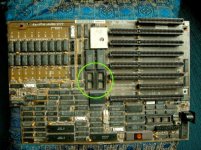Chuck(G)
25k Member
Good to see somebody is still thinking around here.
You and I were thinking the same thing.
Good to see somebody is still thinking around here.
Ok, that worked. Didn't know that trick. Thanks! Now if I could only get this cf adapter to report when the disk is active. Not working on the adapter itself or the led attached to the controller.
After I said that, I had a feeling that it might not. However, you could perhaps partition on another machine first.Ranish wouldn't load with even the disks that worked.
I just got Ranish working on the 286. Didn't realize until digging in the docs that the latest version was only 32bit. I fixed the errors Ranish was finding in the CHS and the partition size info and reformatted the card. Unfortunately nothing has changed. Still can't boot or run anything from the disks partially working. I also got a divide error and crash when running Ranish with the card that wouldn't allow FDisk to run. What a mess, huh?
Divide by 0 error, makes me think you have ram issues, have you run a memory test yet to rule it out? Could be a bad ide cable too...

